On the Factors of Impact Pressure in Supercritical CO2 Phase-Transition Blasting—A Numerical Study
Abstract
:1. Introduction
2. Methods and Models
2.1. Computational Simulation Domain and Boundary Conditions
2.2. Governing Equations of the Simulation
2.3. Real Gas Model for CO2
2.4. Simulation Methodology
2.5. Calculation of the Shockwave
3. Result and Discussion
3.1. Development of the Free CO2 Flow
3.1.1. Starting Transient Evolution and the Shockwave
3.1.2. Development of the Free CO2 Flow Field Structure
3.1.3. Mach Disk Stabilization
3.1.4. Factors Influencing the Pressure Characteristics
3.2. Stagnation Properties of CO2 Impacting Jet
4. Conclusions
- During blasting, the CO2 absorbs heat from the surrounding environment and produces a significant low-temperature area. The pressure due to the shockwave is significantly lower than the driving gas pressure to the ambient pressure, limiting the maximum shockwave over-pressure that can be obtained.
- The blasting pressure is the critical parameter of the shockwave. When the value of P4 increases from 50 to 150 MPa, the ∆P/P1 value increases from 17 to 56. Furthermore, when the filling volume increases from 50% to 100%, the peak fracturing is reduced by 20.2%. The one-dimensional shock tube hypothesis can be used, which can better predict the peak value and attenuation of shockwave over-pressure in the near-field.
- The impact process can be divided into three stages, considering the dynamic pressure curves for the centerline of the jet: A shock stage, a stable stage, and an attenuation stage. In the shock stage, strong compression is formed on the surface of the shockwave, resulting in a higher peak pressure value. Meanwhile, the stable pressure is influenced by the target distance, blasting pressure, and the CO2-PB length.
Author Contributions
Funding
Data Availability Statement
Conflicts of Interest
References
- Kumar, S.; Mishra, A.K. Reduction of blast-induced ground vibration and utilization of explosive energy using low-density explosives for environmentally sensitive areas. Arab. J. Geosci. 2020, 13, 1–10. [Google Scholar] [CrossRef]
- Li, Q.-Y.; Chen, G.; Luo, D.-Y.; Ma, H.-P.; Liu, Y. An experimental study of a novel liquid carbon dioxide rock-breaking technology. Int. J. Rock Mech. Min. Sci. 2020, 128, 104244. [Google Scholar] [CrossRef]
- Shang, Z.; Wang, H.; Li, B.; Hao, C.; Wang, Z.; Zhang, X.; Zhao, F.; Zhang, X. Experimental investigation of BLEVE in liquid CO2 phase-transition blasting for enhanced coalbed methane recovery. Fuel 2021, 292, 120283. [Google Scholar] [CrossRef]
- Pan, H.; Li, J.; Zhang, T.; Li, S.; Zhang, L. Study on crack propagation of the CO2presplitting blasting empty hole effect in coal seam. Energy Sci. Eng. 2020, 8, 3898–3908. [Google Scholar] [CrossRef]
- Zhou, S.; Jiang, N.; He, X.; Luo, X. Rock Breaking and Dynamic Response Characteristics of Carbon Dioxide Phase Transition Fracturing Considering the Gathering Energy Effect. Energies 2020, 13, 1336. [Google Scholar] [CrossRef] [Green Version]
- Liu, X.; Wang, Z.; Song, D.; He, X.; Yang, T. Variations in surface fractal characteristics of coal subjected to liquidCO2phase change fracturing. Int. J. Energy Res. 2020, 44, 8740–8753. [Google Scholar] [CrossRef]
- Xia, X.; Li, H.; Wang, X.; Zhou, Q.; Yu, C. Comparison analysis of the ground vibrations induced by CO2 gas fracturing and explosive blasting. Chin. J. Rock Mech. Eng. 2021, 40, 1350–1356. [Google Scholar] [CrossRef]
- Wang, B.; Qiu, W.; Liu, S.; Sun, H.; Ding, X.; Jin, B.; Zhang, Z. Supercritical CO2 source for underground seismic exploration. J. King Saud Univ.-Sci. 2020, 32, 1731–1737. [Google Scholar] [CrossRef]
- Zhou, S.; Luo, X.; Jiang, N.; Zhang, S.; Lei, Y. Ground vibration characteristics of carbon dioxide phase transition fracturing: An in situ test. Bull. Eng. Geol. Environ. 2021, 80, 9029–9047. [Google Scholar] [CrossRef]
- Kong, R.; Kim, S.; Ishii, M. Review of jet impingement in high-energy piping systems. Nucl. Eng. Des. 2020, 357, 110411. [Google Scholar] [CrossRef]
- Jaimes, M.G.; Castillo, R.D.; Mendoza, S.A. High Energy Gas Fracturing: A Technique of Hydraulic Prefracturing to Reduce the Pressure Losses by Friction in the Near Wellbore-a Colombian Field Application. SPE 2012, 1, 152886. [Google Scholar] [CrossRef]
- Zhang, Y.; Deng, J.; Ke, B.; Deng, H.; Li, J. Experimental Study on Explosion Pressure and Rock Breaking Characteristics under Liquid Carbon Dioxide Blasting. Adv. Civ. Eng. 2018, 2018, 7840125. [Google Scholar] [CrossRef]
- Bai, X.; Zhang, D.; Zeng, S.; Zhang, S.; Wang, D.; Wang, F. An enhanced coalbed methane recovery technique based on CO2 phase transition jet coal-breaking behavior. Fuel 2020, 265, 116912. [Google Scholar] [CrossRef]
- Ke, B.; Zhou, K.; Ren, G.; Shi, J.; Zhang, Y. Positive Phase Pressure Function and Pressure Attenuation Characteristic of a Liquid Carbon Dioxide Blasting System. Energies 2019, 12, 4134. [Google Scholar] [CrossRef] [Green Version]
- Wang, H.; Cheng, Z.; Zou, Q.; Li, Z.; Sun, F.; Yang, H.; Lei, Y. Elimination of coal and gas outburst risk of an outburst-prone coal seam using controllable liquid CO2 phase transition fracturing. Fuel 2021, 284, 119091. [Google Scholar] [CrossRef]
- Zhou, Y.; Liu, Z.; Li, M.; Zheng, D.; Jiang, M.; Shang, C.; Zhao, Y.; Ji, X. Experimental study of the influence of burst parameters on the initiation of CO2 BLEVE. Int. J. Greenh. Gas Control 2019, 91, 102817. [Google Scholar] [CrossRef]
- Lei, Y.; Li, C.; Zhang, K. Study on evolution mechanism of unsteady transient pressure drop caused by gas phase cracking. Saf. Coal Mines 2021, 52, 25–30. [Google Scholar] [CrossRef]
- Xia, J.; Dou, B.; Tian, H.; Zheng, J.; Cui, G.; Kashif, M. Research on Initiation of Carbon Dioxide Fracturing Pipe Using the Liquid Carbon Dioxide Phase-Transition Blasting Technology. Energies 2021, 14, 521. [Google Scholar] [CrossRef]
- Chen, Y.; Zhang, H.; Zhu, Z.; Ren, T.; Cao, C.; Zhu, F.; Li, Y. A new shock-wave test apparatus for liquid CO2 blasting and measurement analysis. Meas. Control 2019, 52, 399–408. [Google Scholar] [CrossRef] [Green Version]
- Zhang, X.; Lu, Y.; Tang, J.; Zhou, Z.; Li, Q. Dynamic simulation of the oscillation characteristics of supercritical carbon dioxide impacting jets. J. Vib. Control 2018, 25, 61–71. [Google Scholar] [CrossRef]
- Wang, X.; Song, Z.; Pan, X.; Zhang, L.; Zhu, X.; Mei, Y.; Jiang, J. Simulation study on near-field structure and flow characteristics of high-pressure CO2 released from the pipeline. J. Loss Prev. Process Ind. 2021, 71, 104481. [Google Scholar] [CrossRef]
- Yang, Y.; Liu, H.; Mao, W.; Song, Z.; Wang, H. Study on the Impact Pressure of Swirling-Round Supercritical CO2 Jet Flow and Its Influencing Factors. Energies 2020, 14, 106. [Google Scholar] [CrossRef]
- Liu, X.; Godbole, A.; Lu, C.; Michal, G.; Venton, P. Source strength and dispersion of CO2 releases from high-pressure pipelines: CFD model using real gas equation of state. Appl. Energy 2014, 126, 56–68. [Google Scholar] [CrossRef] [Green Version]
- Zhou, Z.; Lu, Y.; Tang, J.; Zhang, X.; Li, Q. Numerical simulation of supercritical carbon dioxide jet at well bottom. Appl. Therm. Eng. 2017, 121, 210–217. [Google Scholar] [CrossRef]
- Flechas, T.; Laboureur, D.M.; Glover, C.J. A 2-D CFD model for the decompression of carbon dioxide pipelines using the Peng-Robinson and the Span-Wagner equation of state. Process Saf. Environ. Prot. 2020, 140, 299–313. [Google Scholar] [CrossRef]
- Span, R.; Wagner, W. A New Equation Of State for Carbon Dioxide Covering the Fluid Region from the Triple-Point Temperature to 1100 K At Pressures up to 800 MPa. J. Phys. Chem. Ref. Data 1996, 25, 1509–1596. [Google Scholar] [CrossRef] [Green Version]
- Kang, J.; Zhou, F.; Qiang, Z.; Zhu, S. Evaluation of gas drainage and coal permeability improvement with liquid CO2 gasification blasting. Adv. Mech. Eng. 2018, 10, 687814018768578. [Google Scholar] [CrossRef] [Green Version]
- Yakush, S.E. Model for blast waves of Boiling Liquid Expanding Vapor Explosions. Int. J. Heat Mass Transf. 2016, 103, 173–185. [Google Scholar] [CrossRef]
- Birk, A.M.; Eyssette, R.; Heymes, F. Analysis of BLEVE overpressure using spherical shock theory. Process Saf. Environ. Prot. 2020, 134, 108–120. [Google Scholar] [CrossRef]
- Li, M.; Ni, H.; Cao, Y.; Zhao, B.; Lei, P.; Shi, X.; Du, Y. Flow energy transformation and dissipation mechanisms of carbon dioxide, nitrogen, and water jets. J. Nat. Gas Sci. Eng. 2020, 84, 103650. [Google Scholar] [CrossRef]
- Tang, X.; Asahara, M.; Hayashi, A.K.; Tsuboi, N. Numerical investigation of a high pressure hydrogen jet of 82 MPa with adaptive mesh refinement: The starting transient evolution and Mach disk stabilization. Int. J. Hydrogen Energy 2017, 42, 7120–7134. [Google Scholar] [CrossRef]
- Tian, Z.-C. Crack from the Influencing Factors of Liquid Carbon Dioxide Phase Transient Fracturing. Master’s Thesis, China University of Mining and Technology, Jiangsu, China, 2018. [Google Scholar]
- State Administration of Work Safety. Safety Evaluation; China Coal Industry Publishing Home: Beijing, China, 2005. [Google Scholar]
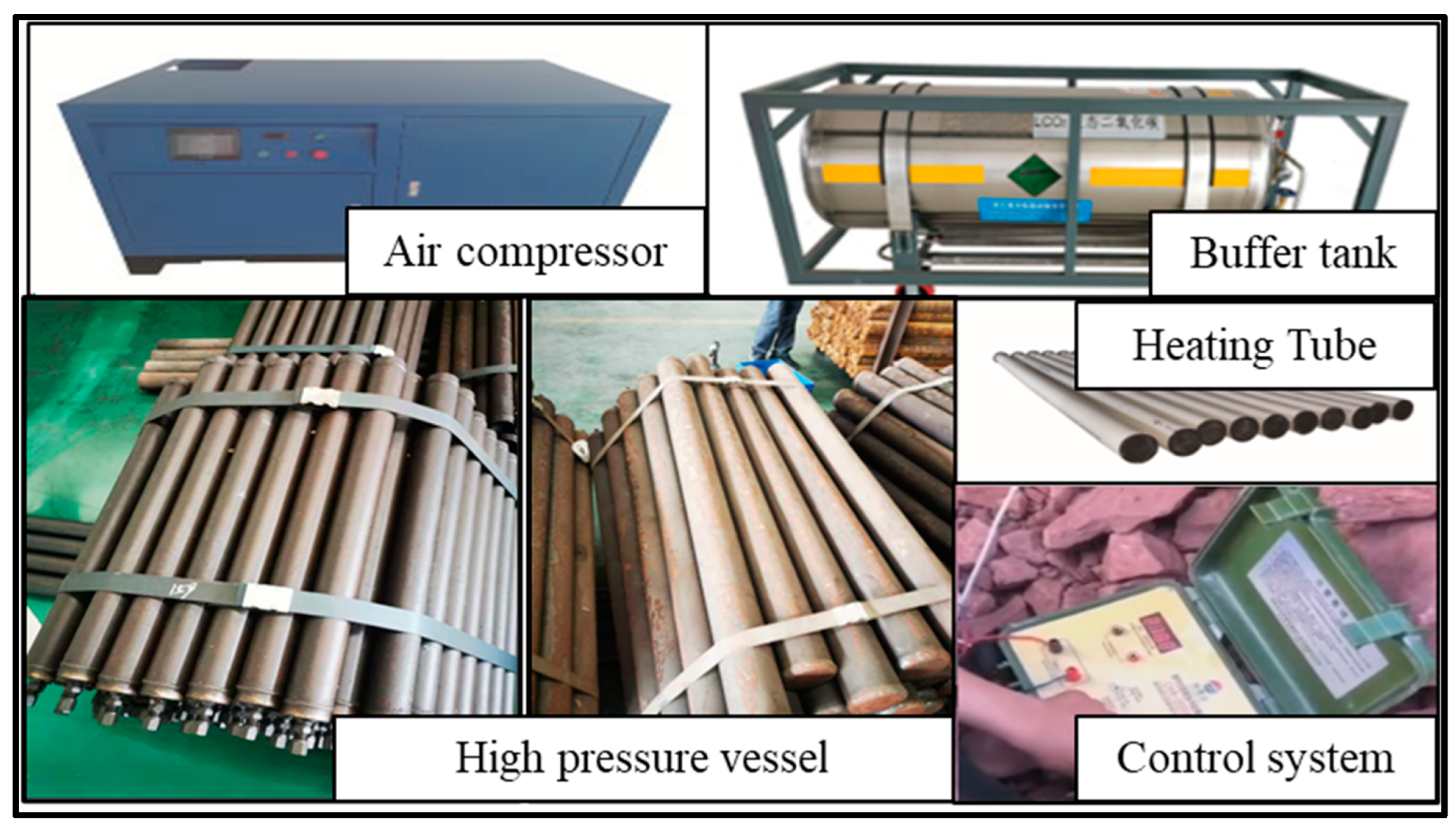
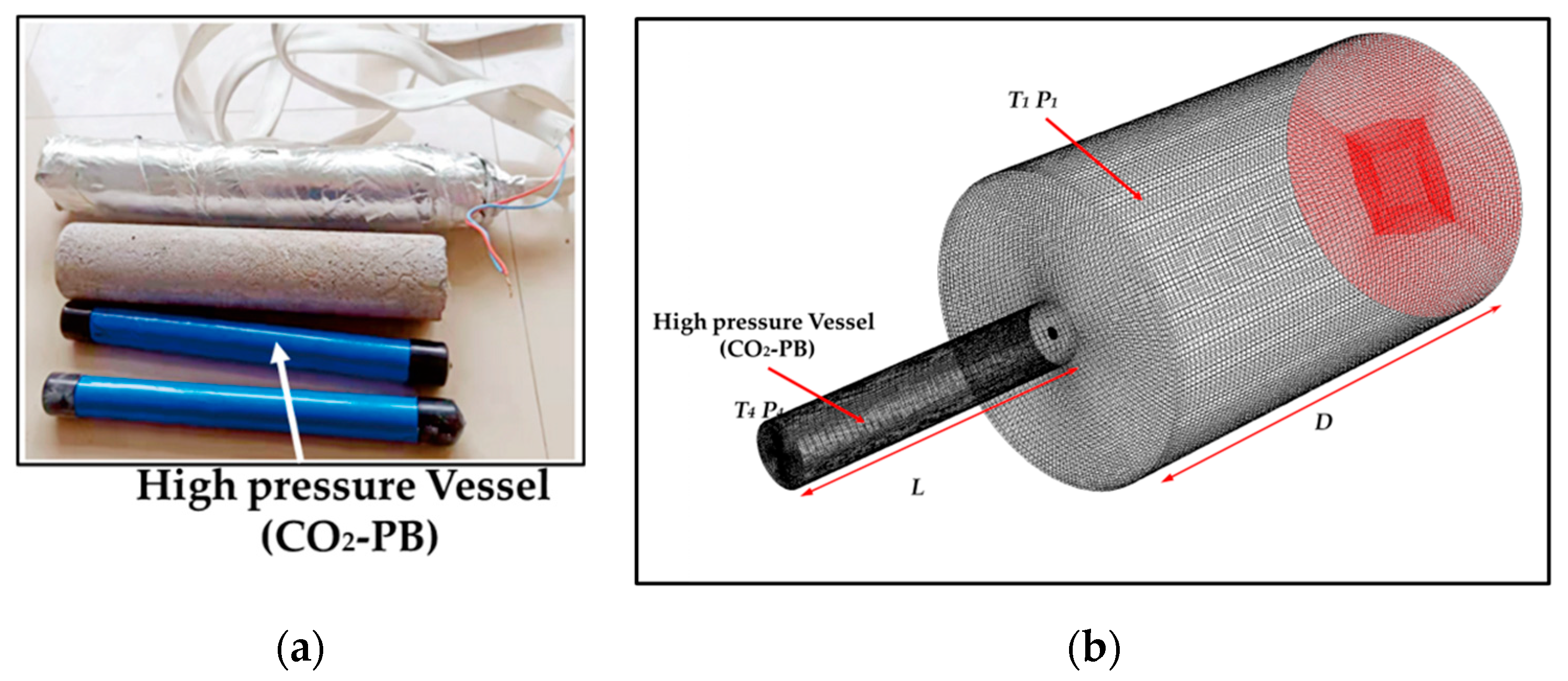
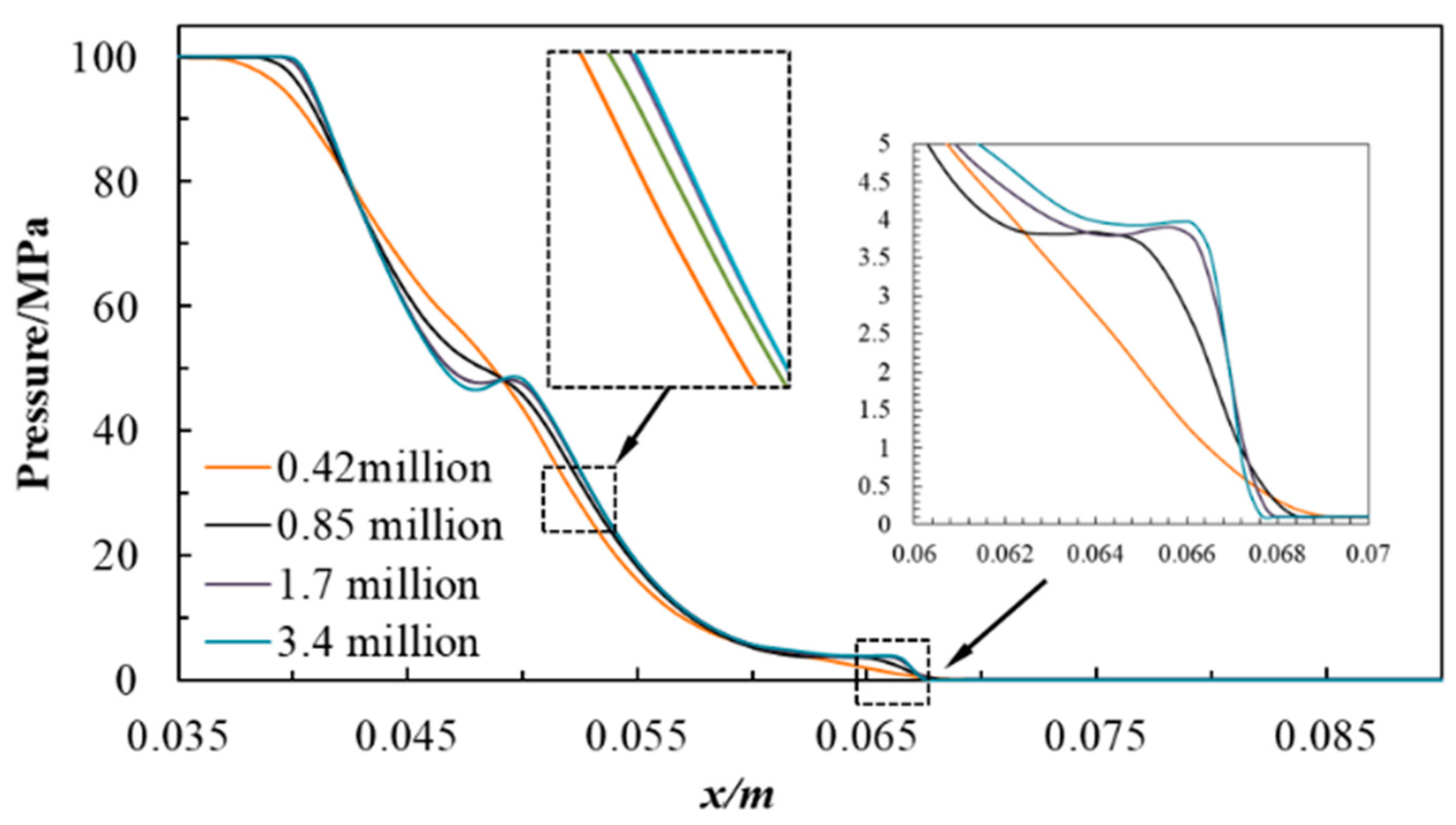
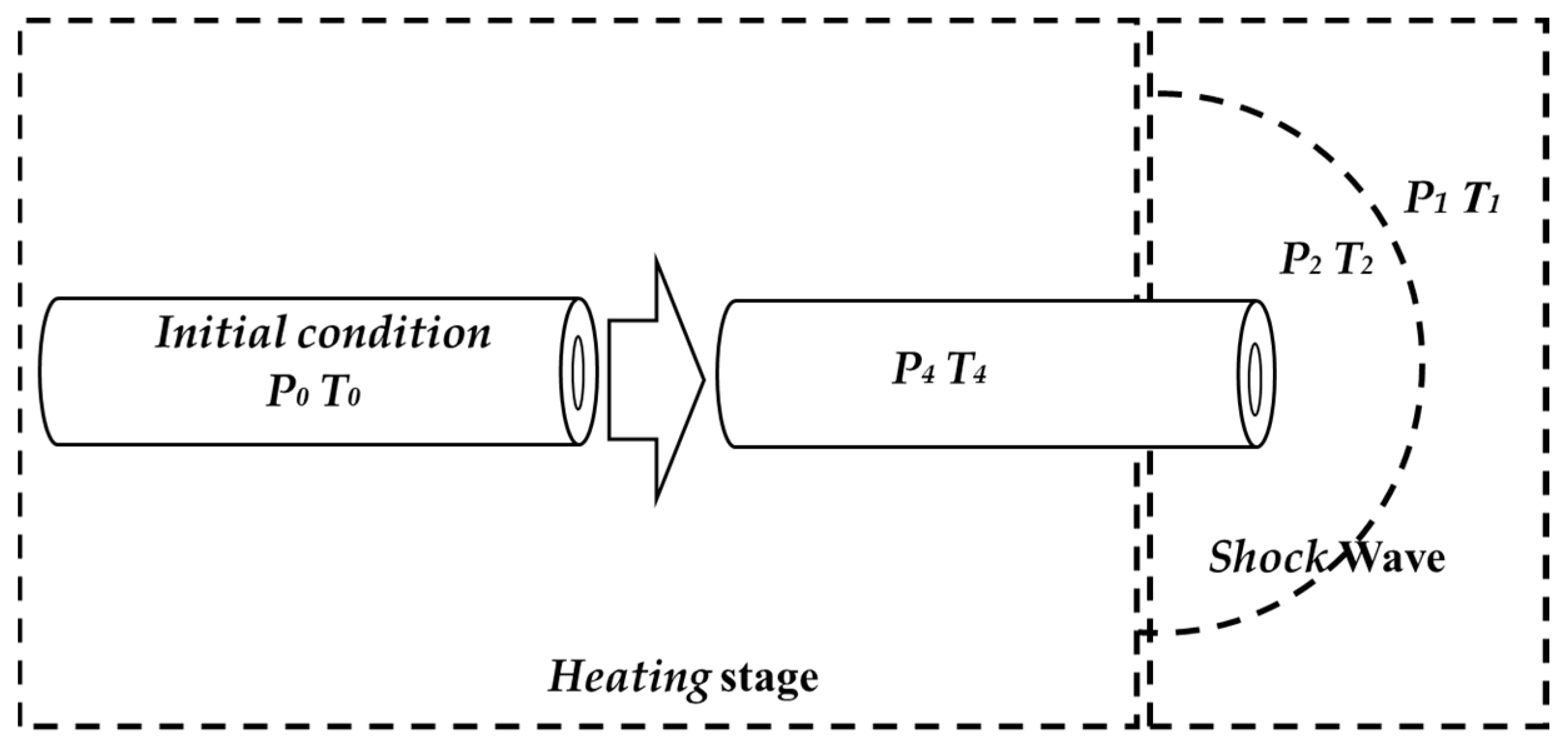

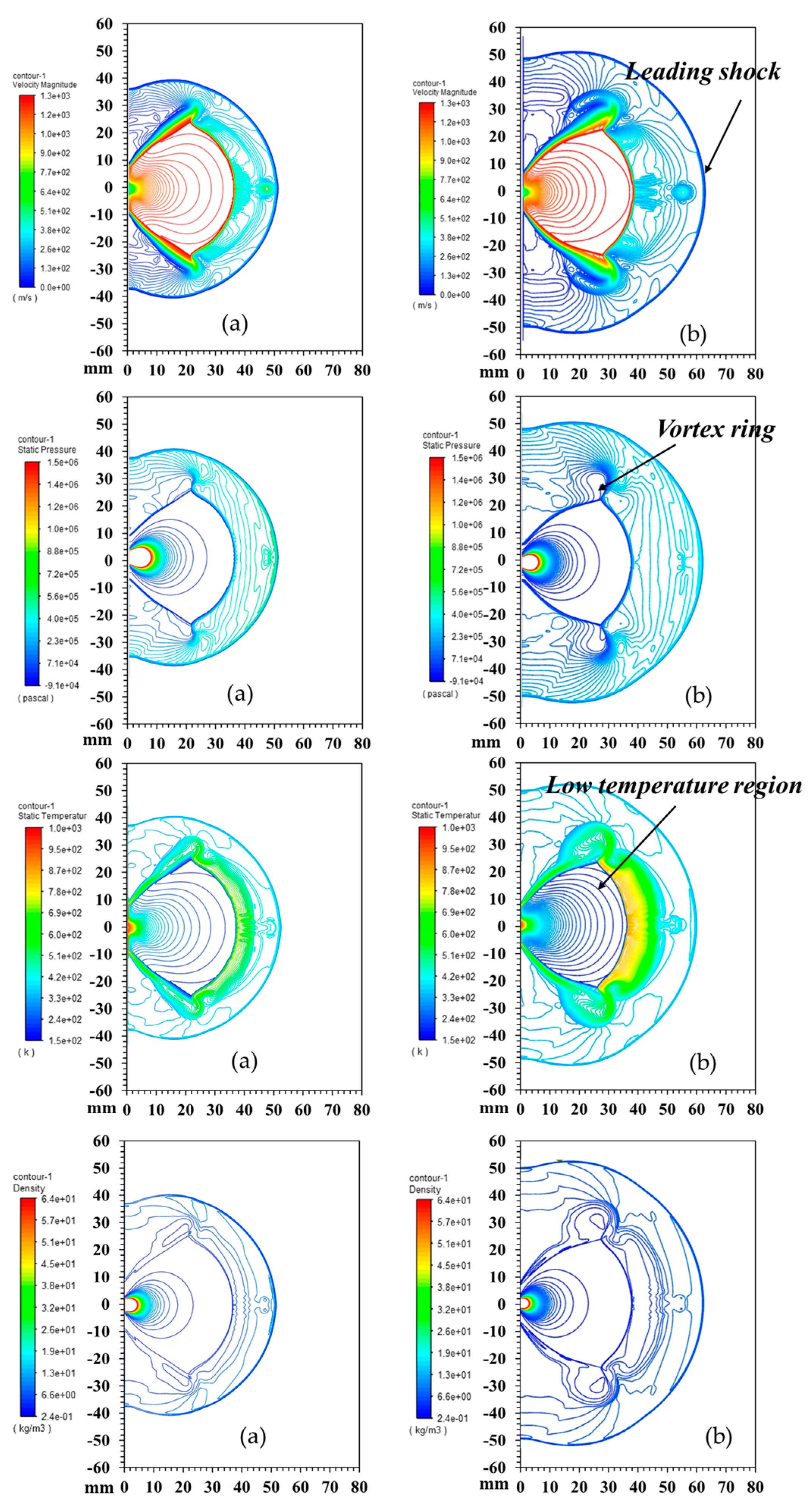
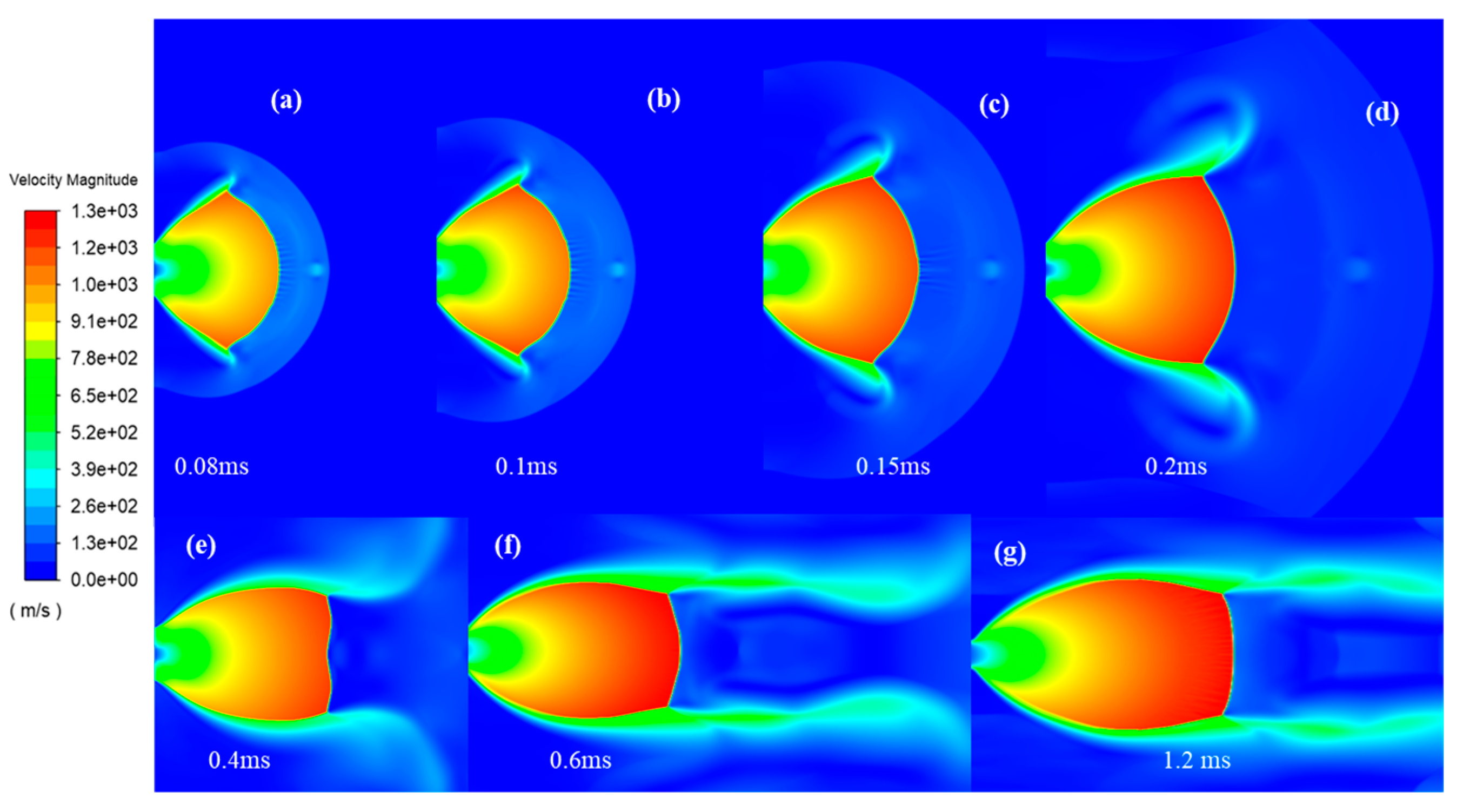
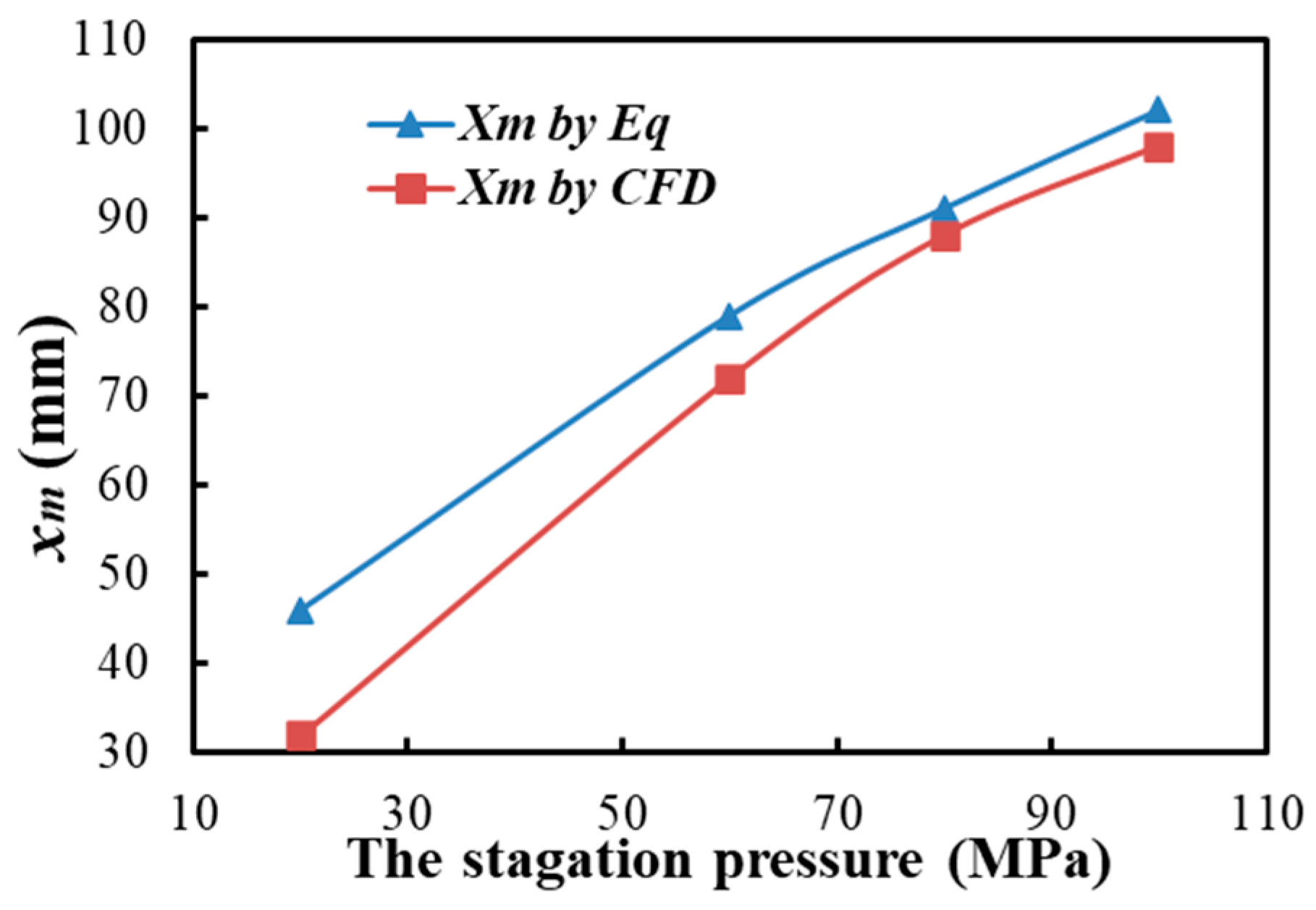

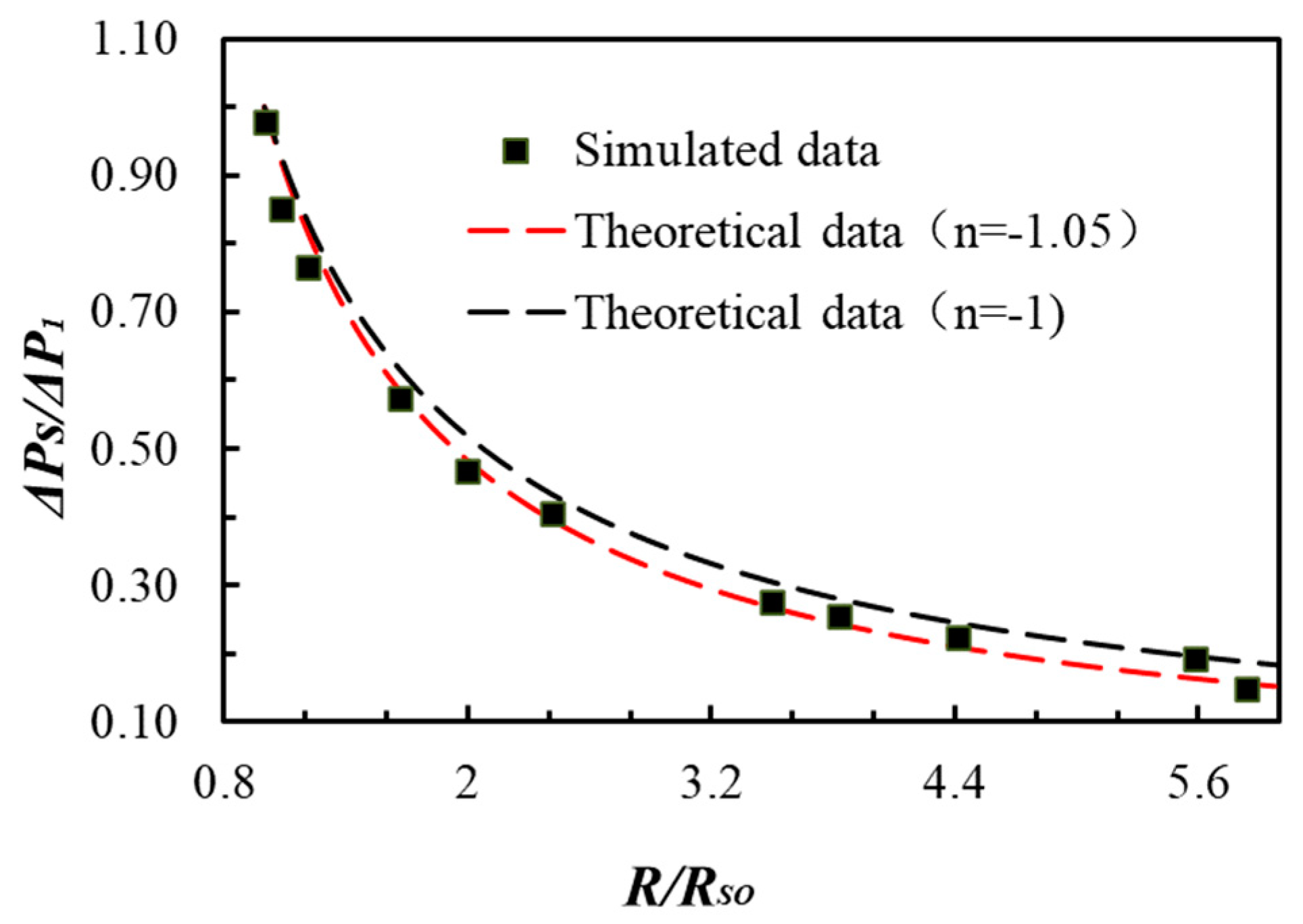
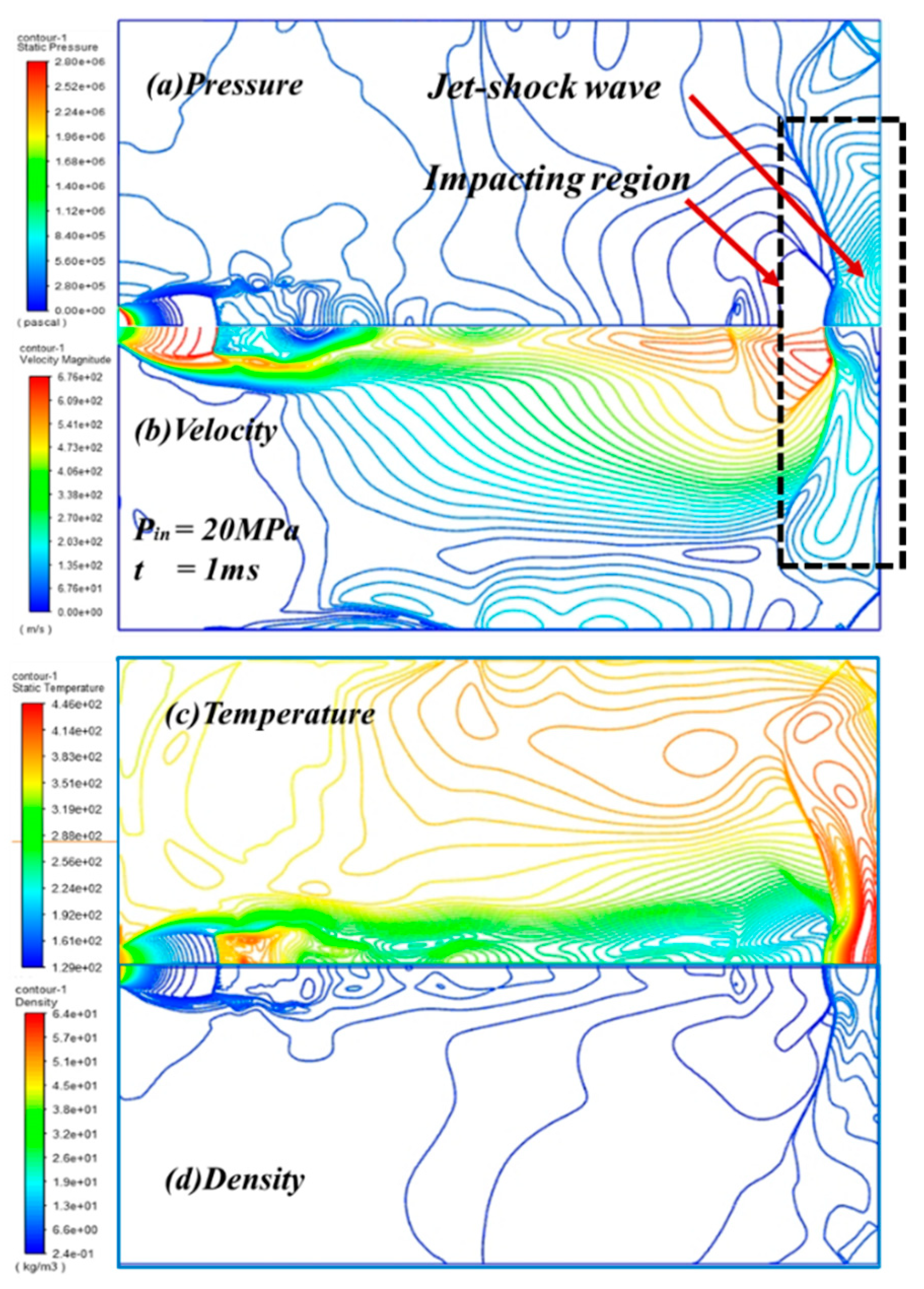

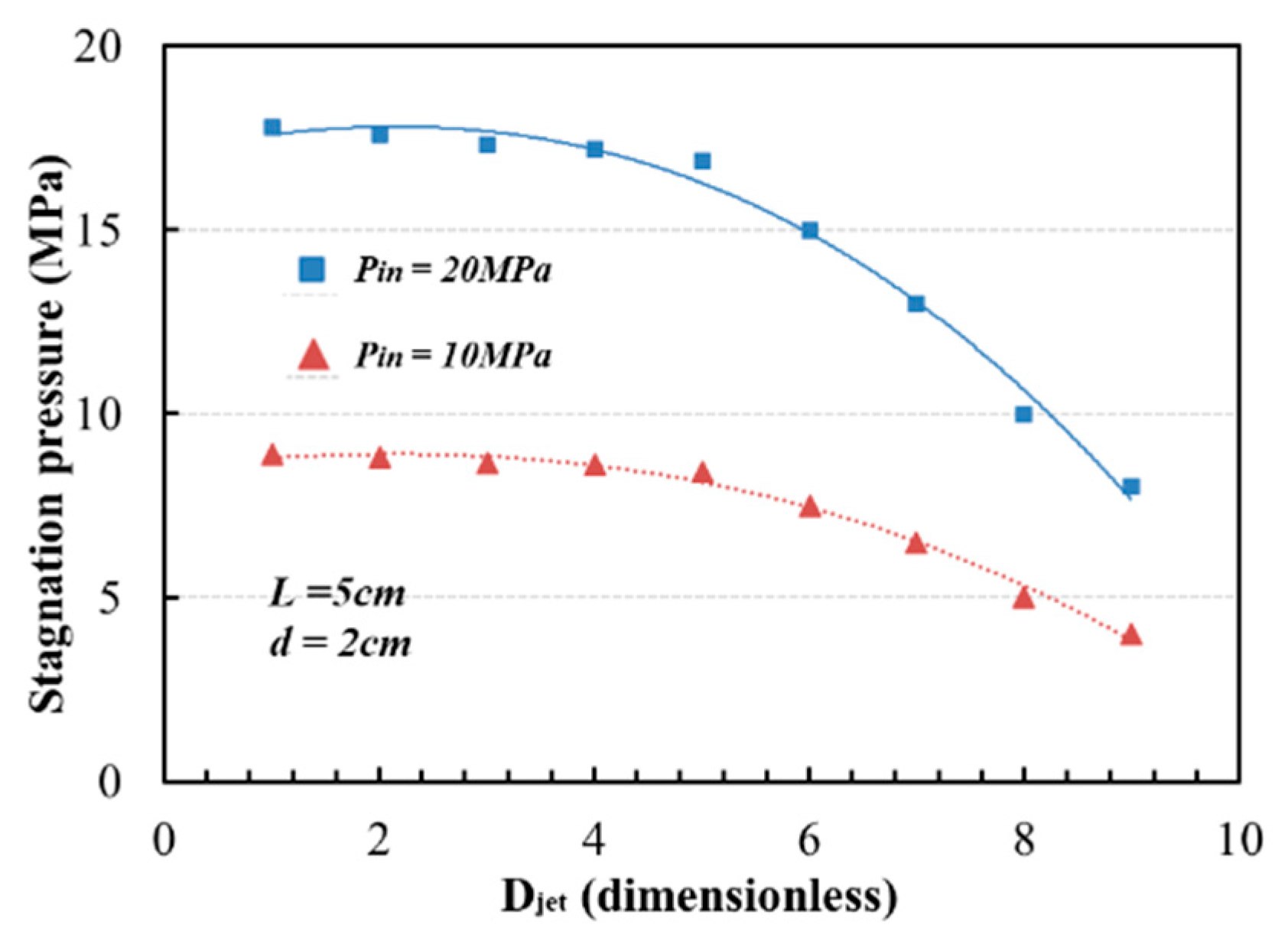
| i | i | ||||
|---|---|---|---|---|---|
| 1 | 8.37304456 | 5 | 0.62105248 | 6.11190 | |
| 2 | −3.70454304 | 6 | 0.41195293 | 6.77708 | |
| 3 | 2.50000000 | 7 | 1.04028922 | 11.32384 | |
| 4 | 1.99427042 | 3.15163 | 8 | 0.08327678 | 27.08792 |
Publisher’s Note: MDPI stays neutral with regard to jurisdictional claims in published maps and institutional affiliations. |
© 2022 by the authors. Licensee MDPI, Basel, Switzerland. This article is an open access article distributed under the terms and conditions of the Creative Commons Attribution (CC BY) license (https://creativecommons.org/licenses/by/4.0/).
Share and Cite
Pu, C.; Liu, Z.; Pu, G. On the Factors of Impact Pressure in Supercritical CO2 Phase-Transition Blasting—A Numerical Study. Energies 2022, 15, 8599. https://doi.org/10.3390/en15228599
Pu C, Liu Z, Pu G. On the Factors of Impact Pressure in Supercritical CO2 Phase-Transition Blasting—A Numerical Study. Energies. 2022; 15(22):8599. https://doi.org/10.3390/en15228599
Chicago/Turabian StylePu, Chao, Zhenjian Liu, and Ge Pu. 2022. "On the Factors of Impact Pressure in Supercritical CO2 Phase-Transition Blasting—A Numerical Study" Energies 15, no. 22: 8599. https://doi.org/10.3390/en15228599




